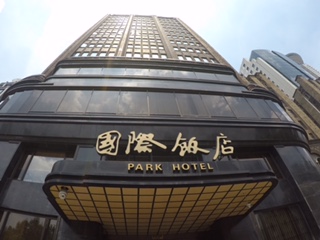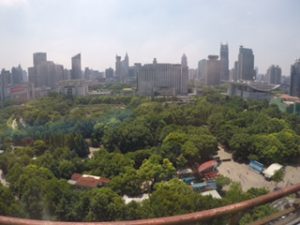What Shanghai’s Park Hotel Reveals

SHANGHAI — When the 22-floor Park Hotel was built here in 1934 it was the tallest building in the city—and it stayed at that lofty peak for nearly 50 years. I’m here exploring this handsome art deco building for a personal reason and a professional one.
I imagine that 77 years ago my father, Stanley Plastrik, came here, too, probably for a meeting, or at least walked past the entrance. The year was 1940. He was 28 years old and an ardent follower of Leon Trotsky. He’d been traveling in the Far East—Ceylon, Japan, India, Singapore, Indo-China (now Vietnam)—and writing articles for “Labor Action” in the U.S. under a pseudonym.
In the 1920s and 1930s Shanghai was known as “The Paris of the East”—an industrial and financial powerhouse run by merchants, a cultural center for Chinese cinema and popular music, and the birthplace of the Communist Party of China. By 1940, though, the city was occupied by Japanese military forces, and western colonial powers still controlled parts of the city, which swarmed with Chinese refugees. It was also home to some 20,000 Jewish refugees who had fled Europe.
My father, writing as "Sherman Stanley," commented:
In Shanghai, the local merchant and property-owning class has a special law unto itself that it puts into constant operation. “Never save for tomorrow what you can spend tonight!” Such is the economic base upon which the innumerable night clubs, gambling joints, brothels, opium dens, horse and dog race tracks, etc., operate.
Probably Shanghai reflects more than any other city the vicissitudes of the modern imperialist world. Nobody knows what will happen next – not the next day, but the next hour! Money (and every kind of money floats around Shanghai) therefore burns fiercely in the pockets of those speculators and compradores privileged to possess it. Nowhere in the world does the bourgeois class so proudly exhibit its inherent vice and corruption as in this city. Particularly now, with important changes shortly to be put into effect, are these people, pursuing the rule of “anything goes.”
He described the desperate economic conditions of Shanghai workers and a wave of strikes that was petering out.
While the strike wave may temporarily die away and the rival imperialists may affect a temporary settlement by handing over all of Shanghai to the Japanese, the “strike or starve” alternative remains and the class struggle of China’s workers will continue.
Nine years later, Chinese Communists declared victory over Chiang Kai-shek’s Nationalist forces and took control of Shanghai.
I also imagine hanging out at the Park Hotel will help me to understand something of Shanghai’s development as a modern megacity. For that, I lead my translator-guide, Eva Hsu, cofounder of LinguaPass Communication, to an elevator and up to the 13th floor, the highest we can access.
 The Park Hotel was designed by a Hungarian architect and looked something like the American Radiator Building constructed in midtown Manhattan about 10 years earlier. The architectural style at the time was modeled after British and American design. It's a dark brown brick building, the first three floors finished with polished black granite, and an art deco lobby. Many of the grandest-scale buildings on the city's riverside promenade, the Bund, were constructed or renovated at this time. The city created a distinct image that separated it from Chinese cities that had come before it.
The Park Hotel was designed by a Hungarian architect and looked something like the American Radiator Building constructed in midtown Manhattan about 10 years earlier. The architectural style at the time was modeled after British and American design. It's a dark brown brick building, the first three floors finished with polished black granite, and an art deco lobby. Many of the grandest-scale buildings on the city's riverside promenade, the Bund, were constructed or renovated at this time. The city created a distinct image that separated it from Chinese cities that had come before it.
The hotel, reported English newspaper China Press at the grad opening, was the first step toward raising Shanghai from the level of a common city to a “leading” city. “A skyscraper today is the first sign of real modernity because it requires all the most up-to-date mechanical devices of man to perfect it. In other words, it is the quintessence of 20th century engineering and skill just as the Pyramids were to Egypt 2,500 years ago and the Great Wall was to China 2,000 years ago,” the paper reported. In a 1950 municipal survey, the flagpole of the Park Hotel was referred to as “Zero Center Point of Shanghai” because of its central location and height. A guest at the hotel, a westerner, wrote about his room in 1938: "The appointments, the bath and the service are just like in any first-class hotel in New York."
Now Shanghai is a thoroughly modern city with modern systems, including the world's longest subway system and more skyscrapers than most cities. Historians say this is a relatively recent development, since the city was mostly neglected for decades before being unleashed economically. Many cities go through swings like this--often due to political mismanagement. New York City was financially dead in the 1970s. In the 1980s, Copenhagen--now celebrated as one of the world's best cities--was losing population and going bankrupt. Melbourne's population had shrunk--incredibly--to the hundreds before the city rebounded and is now growing rapidly.
In 1983 the Park Hotel's height was finally surpassed by another Shanghai building, and a building boom that started in the 1990s has transformed the city skyline and dwarfed the Park. The race track that was on the other side of Nanjing Road West when the hotel was built is now leafy People's Park.
But the model of the modern global city is changing. Shanghai is one of several dozen cities that is now reaching for a different approach to development, one that recognizes that transformational impact of the renewable energy revolution, the "smart city" revolution in information technology, and the need to build urban resilience to sea level rise and other dangerous climate changes. I traveled to Shanghai to study some of the city's climate and energy innovations: a carbon-trading market, the most electric vehicle sales of any metro area in the world, a district for energy-efficient buildings, an analysis of the city's risks from flooding, and more. Shanghai and cities around the globe are making deep, high-impact changes.
Anna Greenspan, a Shanghai-based philosopher, writes in Shanghai Future: Modernity Remade that Shanghai and China have long emulated western city building approaches, but that this is perhaps coming to an end. "Is Shanghai capable of a creative flourishing influential enough to impact the world?" she asks. "Are we nearing a threshold in which it is no longer modernisation that is changing China but rather China that is changing what it is to be modern?"
I would ask the question differently: Are Shanghai and other world-class modern cities (Copenhagen, Melbourne, San Francisco, and Vancouver, for instance) reinventing themselves in ways that leave behind the modern-city model--changing what it is to be modern--and create a different approach to city growth and development? From a visit to Shanghai and some of these other innovative cities, the answer is clearly yes--and that's the subject of the book I'm writing with John Cleveland.
But from my seat in the coffee shop in the lobby of the 83-year-old Park Hotel, as I sip on an iced coffee nearly as expensive as a one-night stay when the hotel opened, there's another answer. As cities change, as buildings and lifestyles change, not everything changes. Some things--this quiet interior hosting people from around the world--seem timeless too. For all the changes in Shanghai since 1934, the Park Hotel is still here doing what it's always done, and maybe did for my youthful father.
The rise of modern city China


